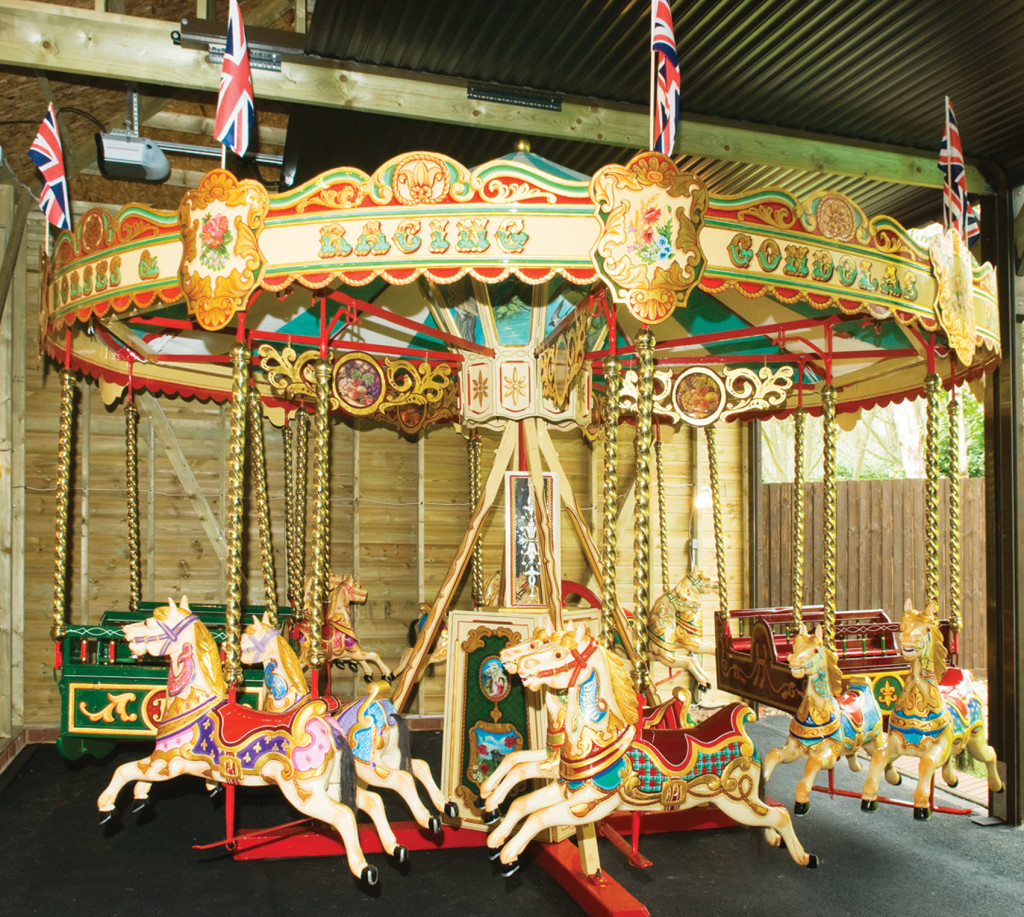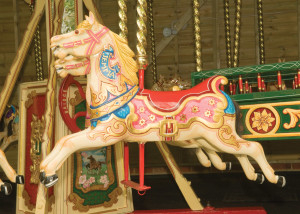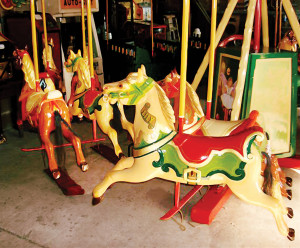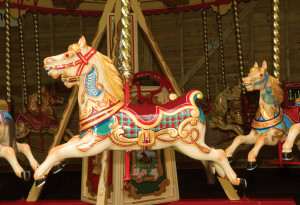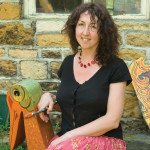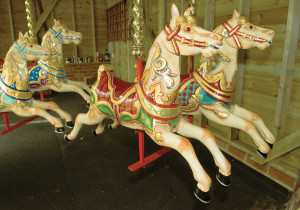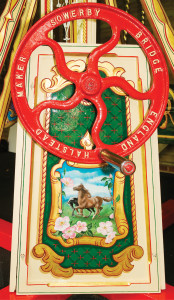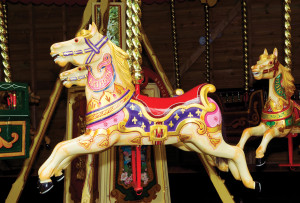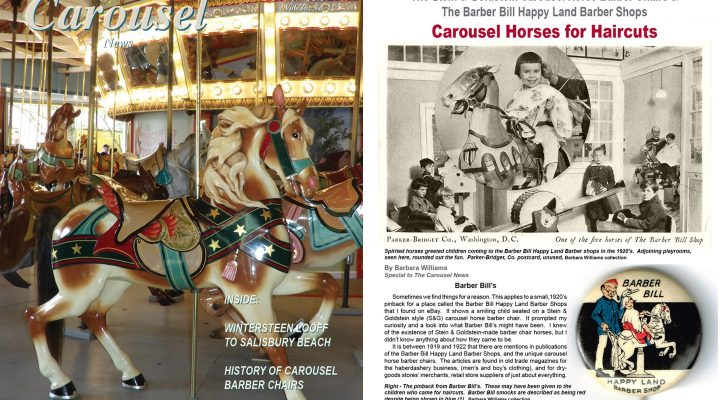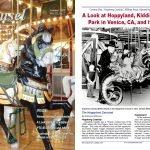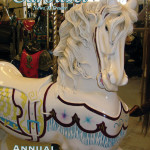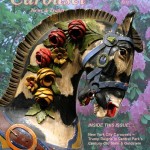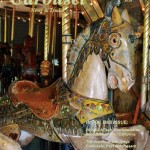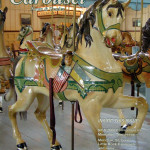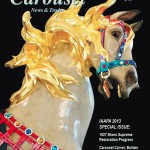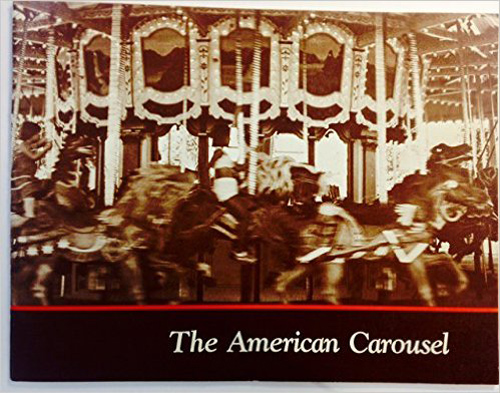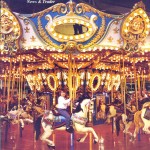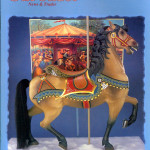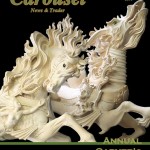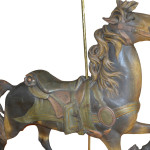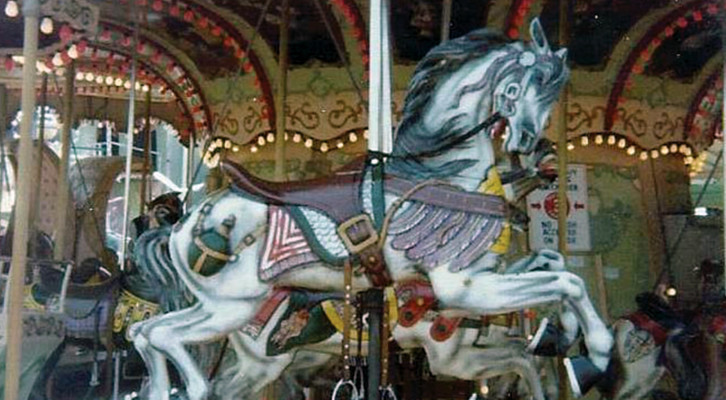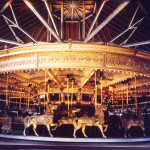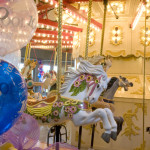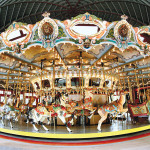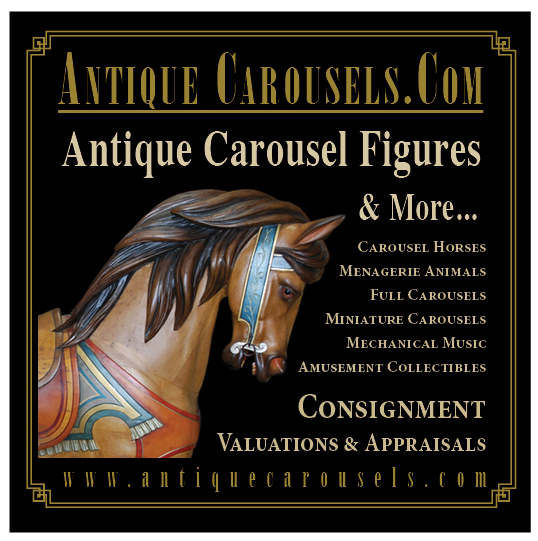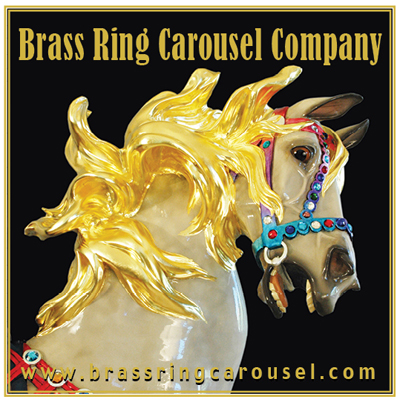Restoration of an English Halstead 1890s Juvenile Dobby
Artist Katie Morgan Brings Victorian Beauty Back to
the Anderson-Carved Gallopers
By Brian Steptoe with John Barker
Reprinted from The Carousel News & Trader, July 2008
Readers will appreciate that there are differences in wording used for amusement rides between England and the U.S. – it was ever thus. Adult roundabout rides are correctly called “gallopers” (all have jumpers as there are no adult rides with stationary platform animals) and kiddie rides are called “juveniles.” Roundabouts which have hanging animals without any platform, are called “dobbies.” This story is about a juvenile dobby ride, one that dates from the 1890s.
Another difference between our descriptions is because English galloper and dobby manufacturers in most cases bought their animals from outside carvers. The most well-known were Andersons from Bristol and Spooners from Burton-on-Trent. The rides are described as being by the makers of the mechanisms, instead of named by the carvers. The major adult galloper makers were Savages, Tidmans and Walkers. The firm of W.H.Halstead from Yorkshire was the most well-known early maker of juvenile rides. The company was in business from the 1880s until it closed in 1933. So here we have a Halstead ride populated with Anderson wooden juvenile-size horses.
Halstead Ride
The traditional English traveling fair of Victorian and Edwardian times was re-created by the late John Carter in 1982. It is now operated by Anna Carter and her family. It includes their 1895 adult Tidman galloper ride and two Halstead-style rides for younger children. John Carter purchased a number of early-dated rides or parts of rides as
the fair became established. Among these was a Halstead, which was bought from a Geoff Cantwell in the mid-1970s. It was kept in storage by the Carters for 30 years. When the time came to have a major clearance of fairground artifacts in order to make more space for growing families in the Carters’ winter quarters in autumn 2006, this 14-foot diameter Halstead was looking for a new home. The ride was purchased by John Barker, a collector of historic fairground art and author of “Roundabout Relics”. John had been looking for such a ride for about 35 years, and although others had been available, they had always suffered from major alterations from the original. But this one was different; it still had its set of Anderson-carved wooden horses, two wooden gondolas, an original cast iron, hand-turned wheel and even its bell was embossed with the W.Halstead initials.
The ride is believed to be totally original, with its metal rounding boards, the 12 Anderson horses all differently carved and the inner row slightly smaller than the outer row. The horse measurements are: inner row chest to rump 20”, ear to foot 26”; outer row chest to rump 24”, ear to foot 28”. They have unusual saddle and blanket designs and carved designs are on the necks of the outer horses, something that usually appears only on full-size galloper animals. The two gondolas have been made so that one fits closely inside the other for packing the ride for moving. The best estimate for the date of manufacture is c.1890-1895, the earliest date being when Andersons started its fairground carving and the later date from when these rides were offered with model motor cars in place of gondolas, real cars being the latest invention.
The ride was offered for sale by the Carters after having the animals stripped back to bare wood, damaged areas repaired and repainted up to a basic gloss paint level with a little decoration, and with the metal rounding boards painted in plain cream, so as to be in a respectable condition for sale. After purchasing the ride, John Barker commissioned fairground artist Katie Morgan to fully restore the ride to its original Victorian splendor.
About Katie Morgan, Artist
Katie went to the Bath Academy of Art, where her degree in Visual Communication included illustration, bookbinding and printing. From her early teens she was very interested in British folk art, where some of the best examples were seen on traditional canal boats, gypsy wagons and at fairgrounds. She was always in awe of the fairground artwork that was produced by Fred Fowle.
Kate managed to make contact with Fowle and would visit him in his workshop in Battersea, South London whenever her college arranged trips to London for its students. She soaked up the knowledge of the oil paints he used and how his work was created.
After college, Katie spent two years working on restoration of fairground animals and artifacts for Relic Designs, which used to run annual auctions at Brillscote Farm in Wiltshire. Her speciality is her ability to retain an antiqued-style in her painting and replacing missing sections on showfronts, horses and ticket signage. Katie learned about the design styles and skills required for restoration while she was at Brillscote.
Each of the 12 horses on John Barker’s Halstead are now painted in different patterns and colors, always keeping to the known styles used in Victorian times. Horses on these juveniles would only be lightly carved, but they would have scrollings painted on to simulate fuller carving. All the animals have to be light in weight as the entire ride is hand-turned by a crank at the centre. Katie mentions that one of the temptations to be avoided is to not be over-elaborate with decorative work and knowing when to stop in order to be true to Victorian originals. All the painting is hand-applied oil paint. For example, the restoration sequence for the horses was priming, undercoat and topcoat, with several coats as required, and sanding, plus any small repairs between coats. The base colors would go on first, then the gilding, and then finer paintwork details. Finally, all were varnished.
The panels at the top centre of the ride are of birds and include macaws, a favorite of John Barker’s. The bottom centre incorporates two carved panels, one with a “J” and one with a “B,” which by coincidence, Katie had as leftovers from a dilapidated carved wagon. The carved motifs on these set a style for repeated use on other areas of the ride. The rounding boards include painted rope-work, which is another favorite of Katie’s and fits with the Victorian era, as do the flowers which are on each of the panels that cover the joints on the rounding boards.
In all it has been a very satisfying job for Katie, dealing with a complete ride. We hope readers will share that feeling and visit this rare Halstead which is now a joy to behold. More of Katie’s work can be seen on her website www.kbmorgan.co.uk.
– John Barker & Brian Steptoe.
All photos by Brian Steptoe except where indicated (2 Carter photos)
Reprinted from The Carousel News & Trader, July 2008.
Read the Full Issue Online >>>

